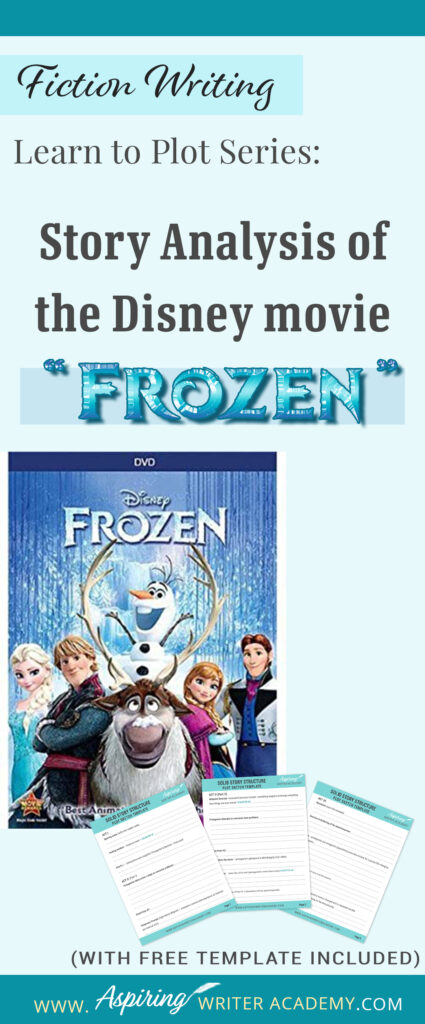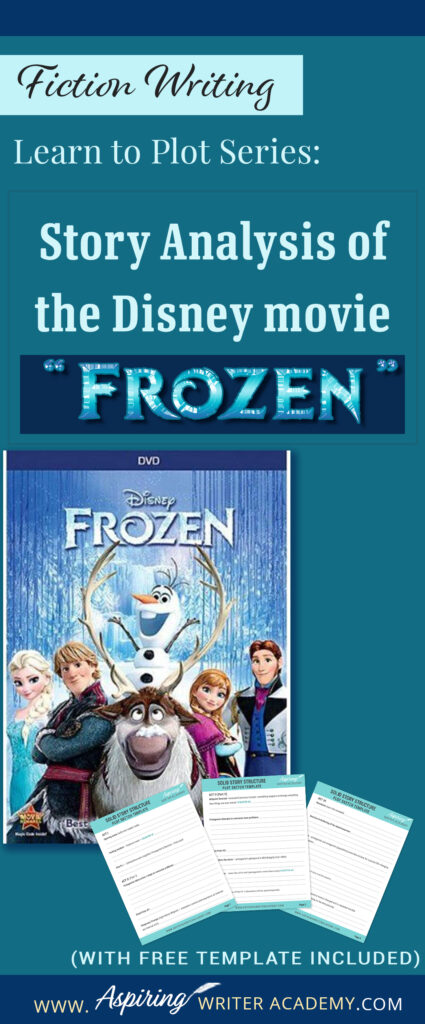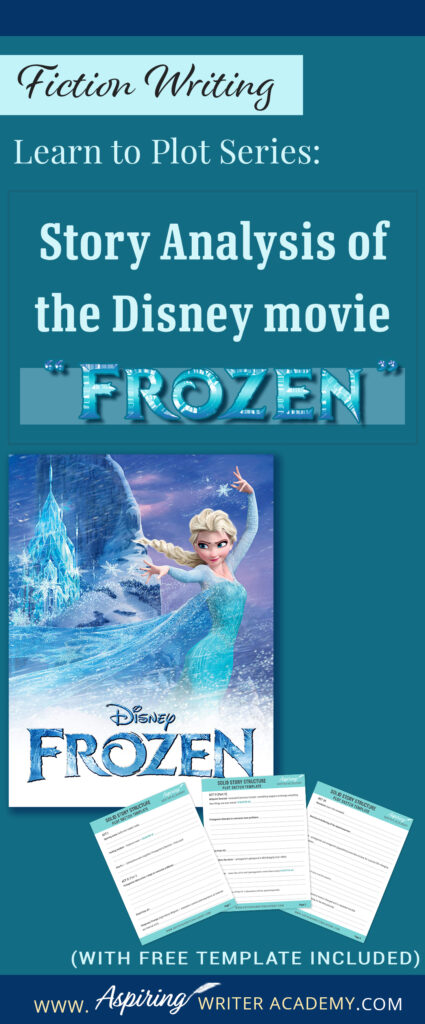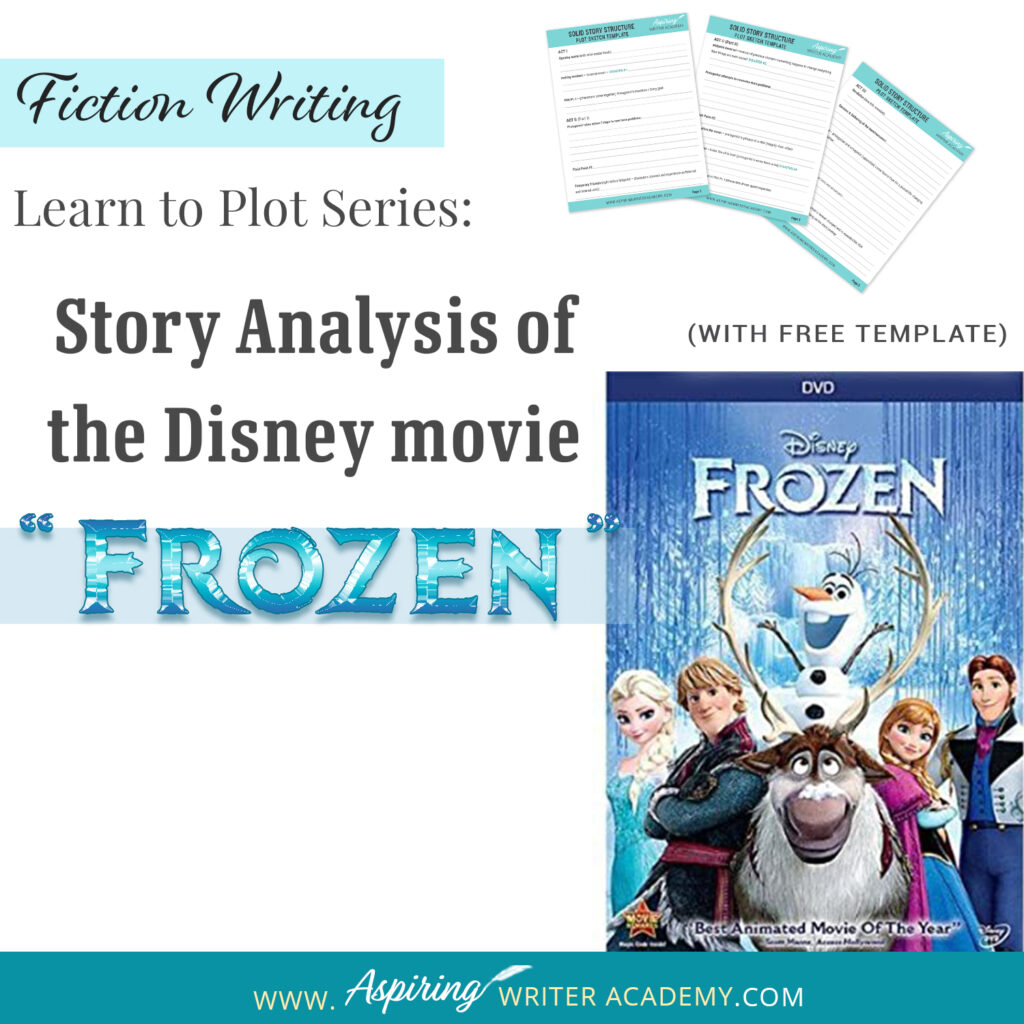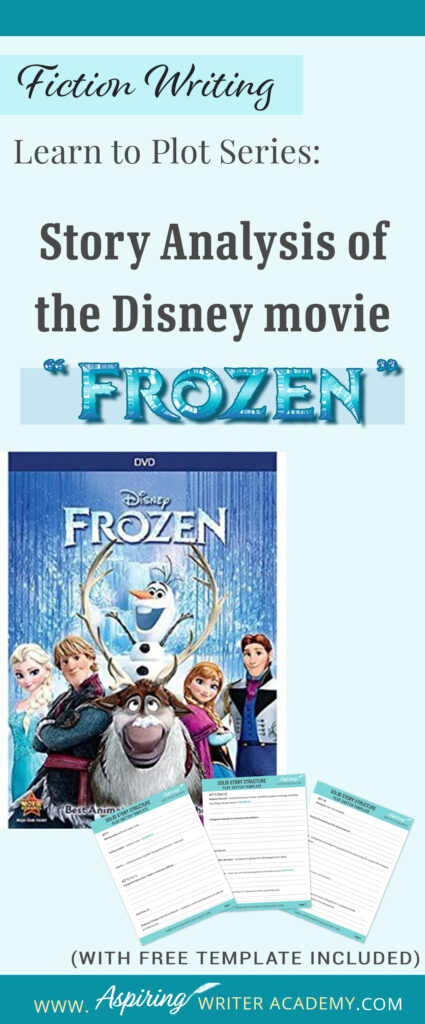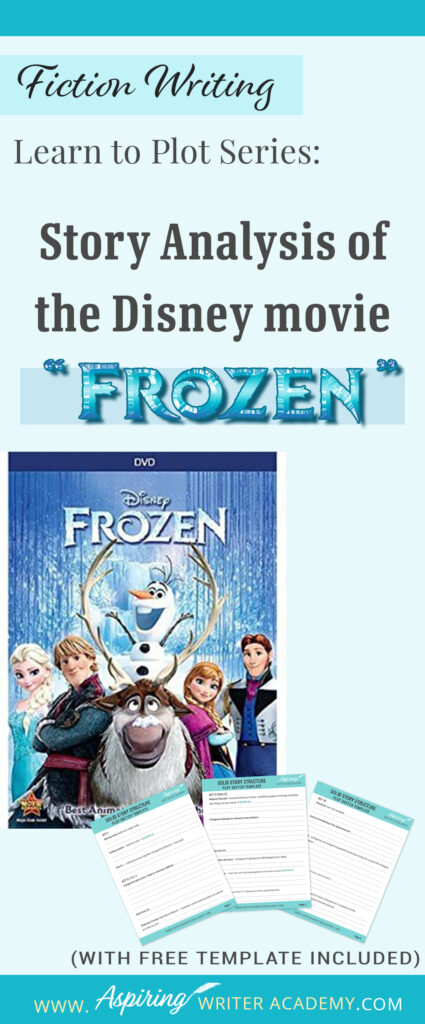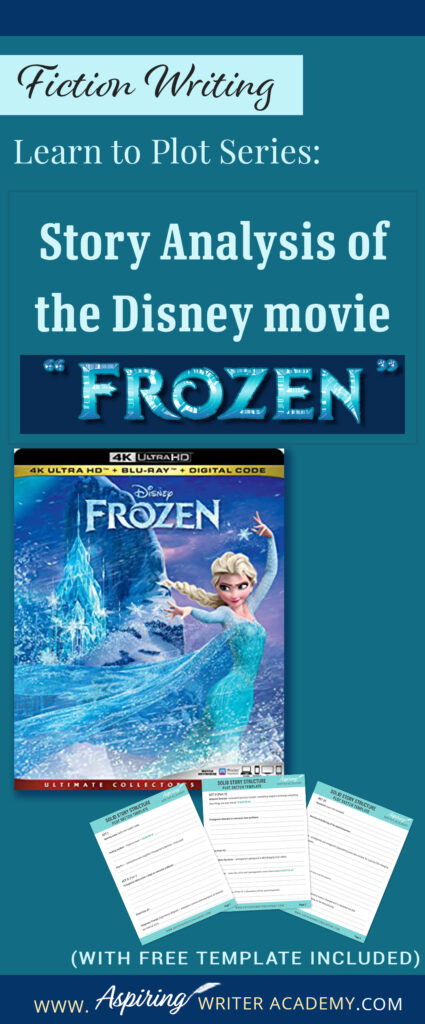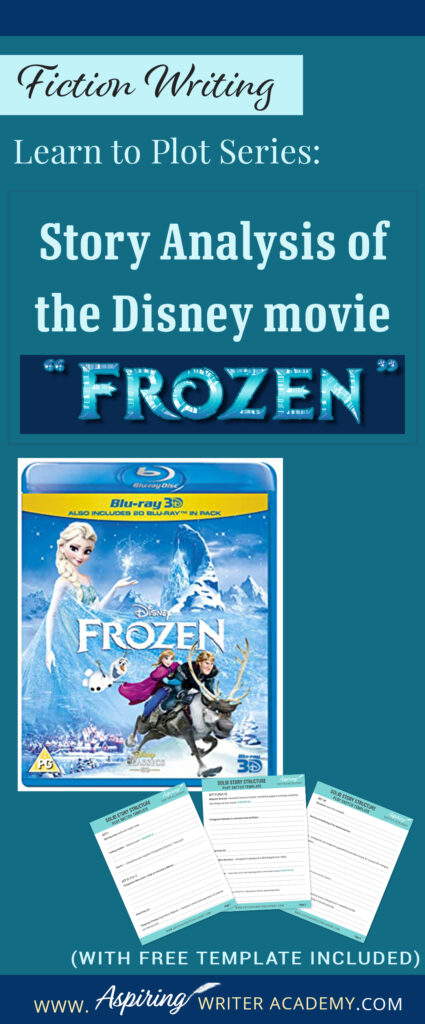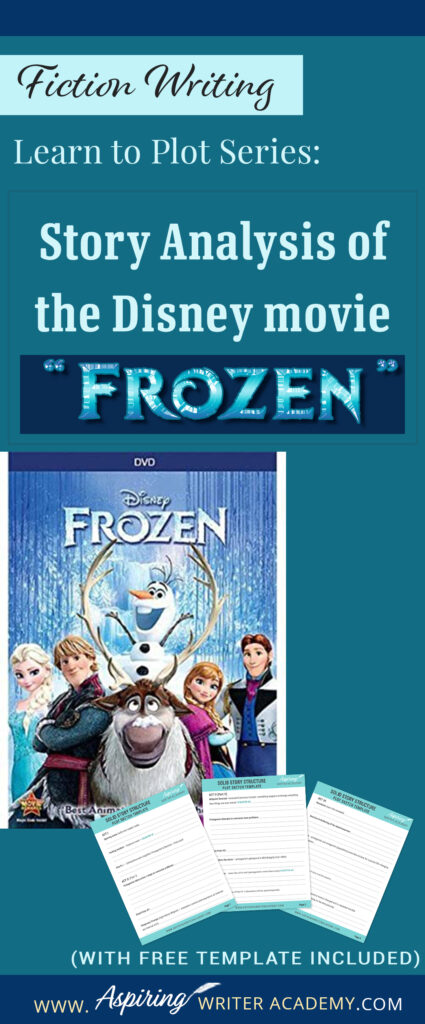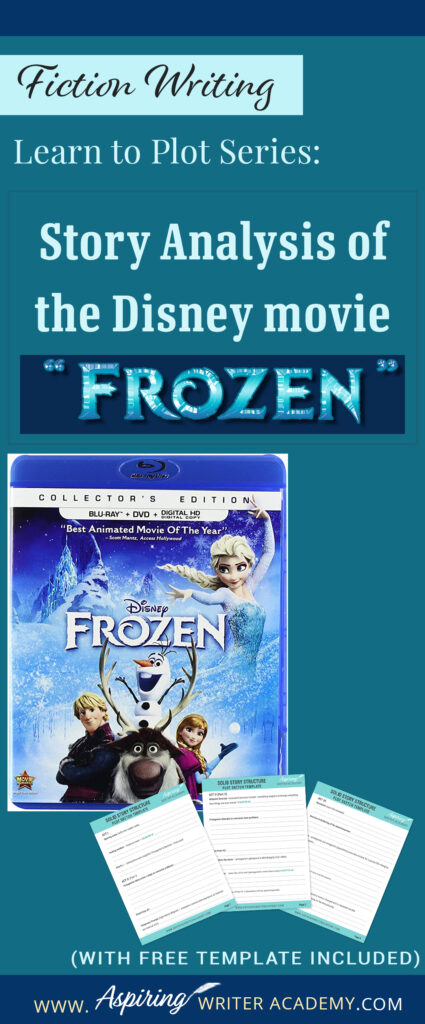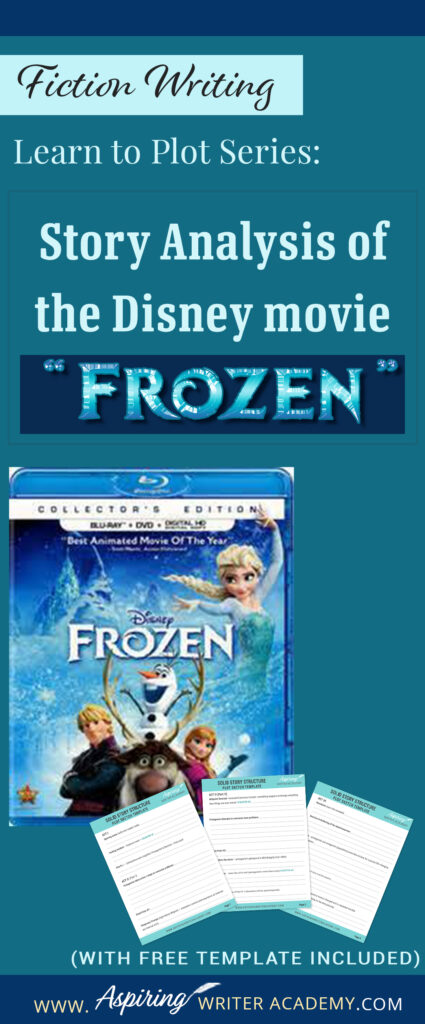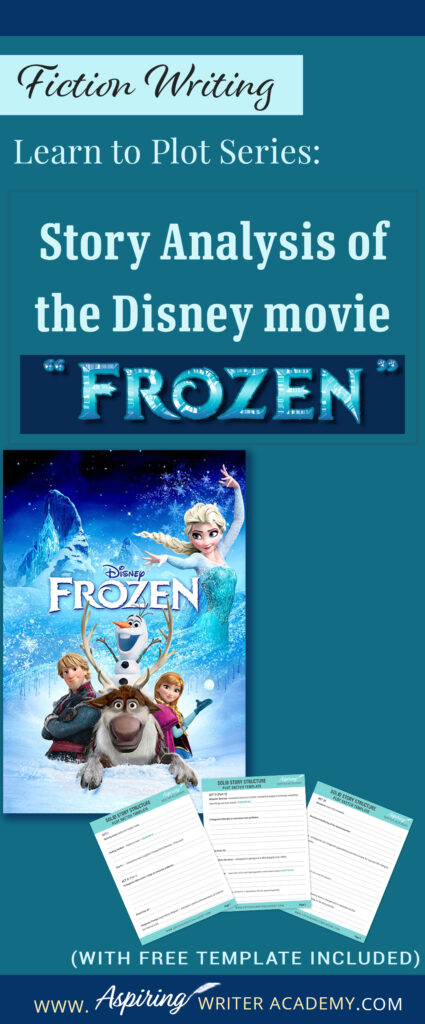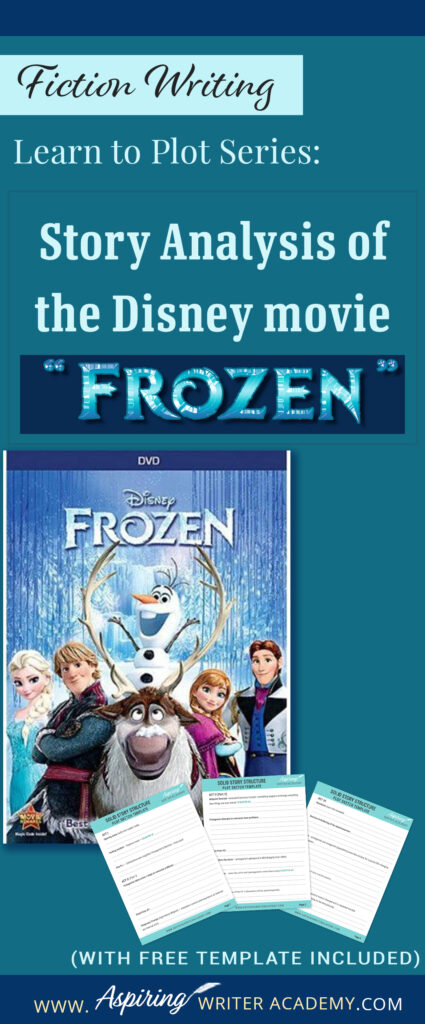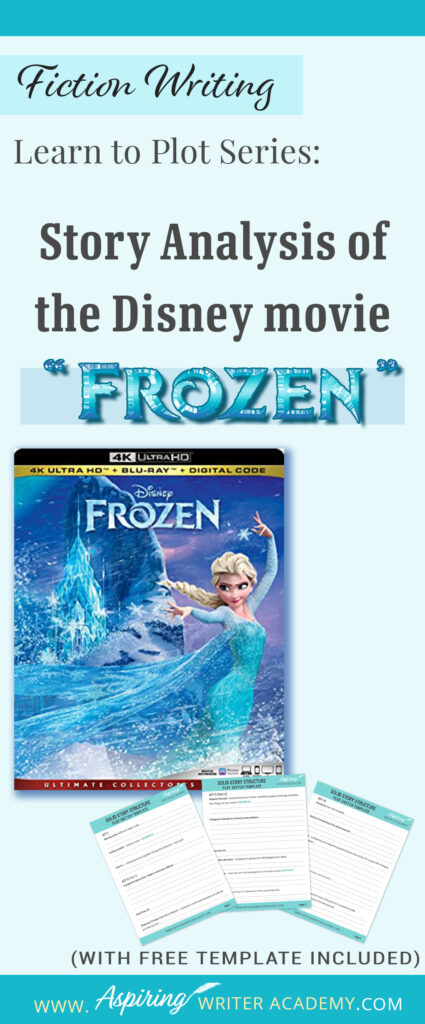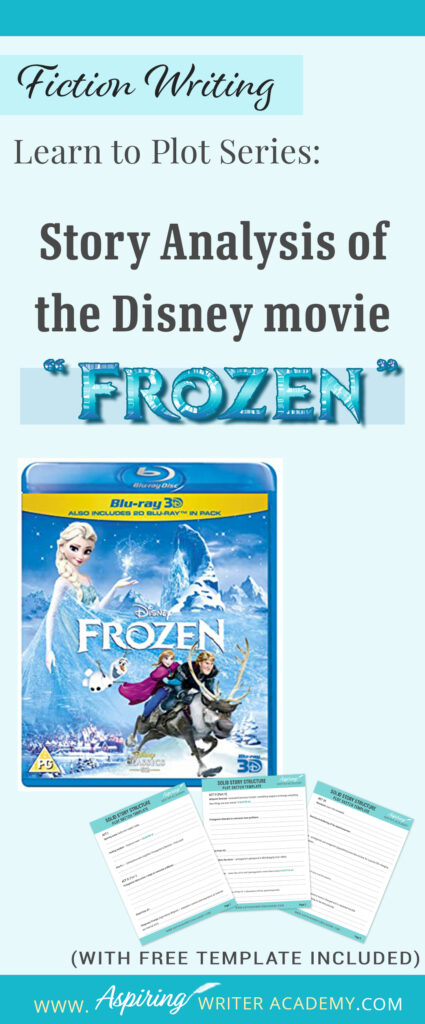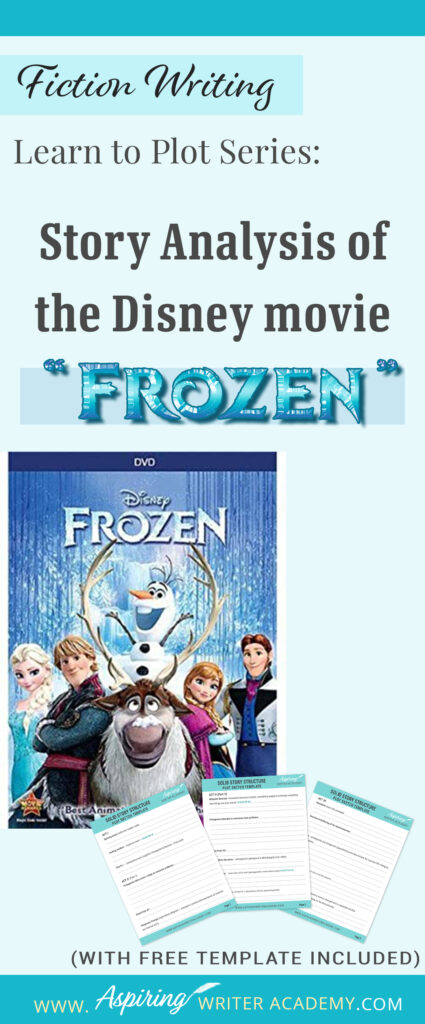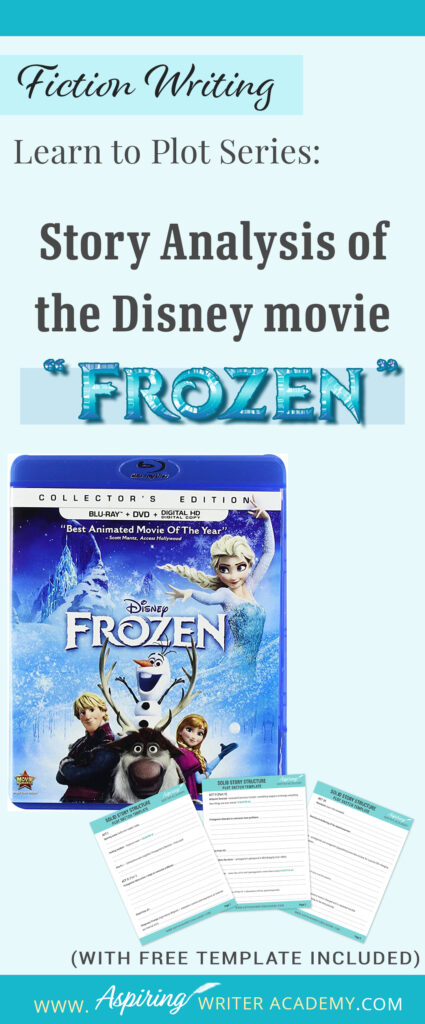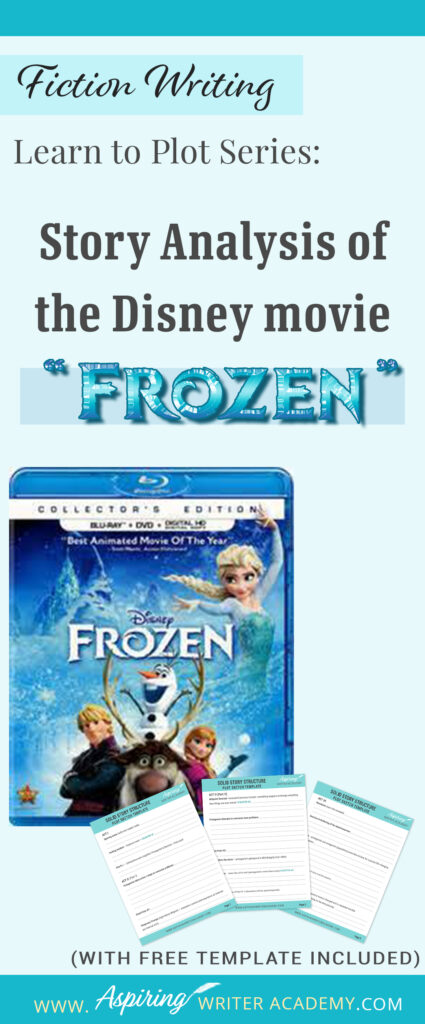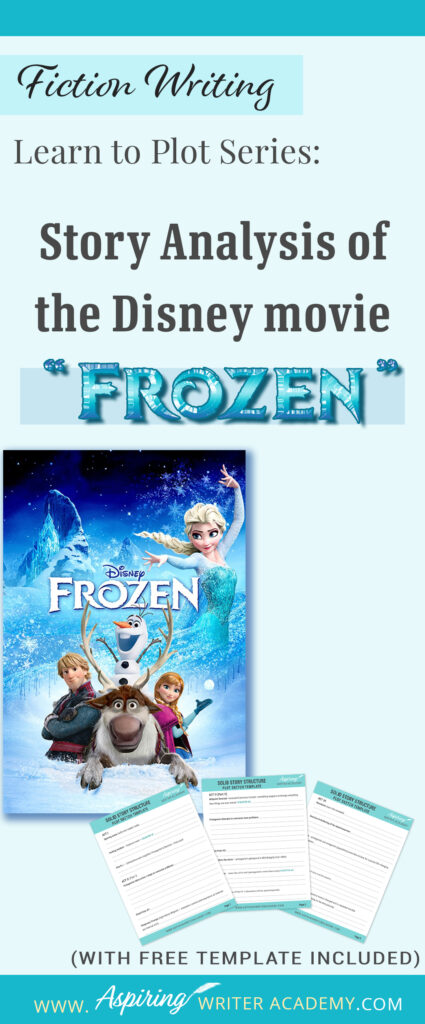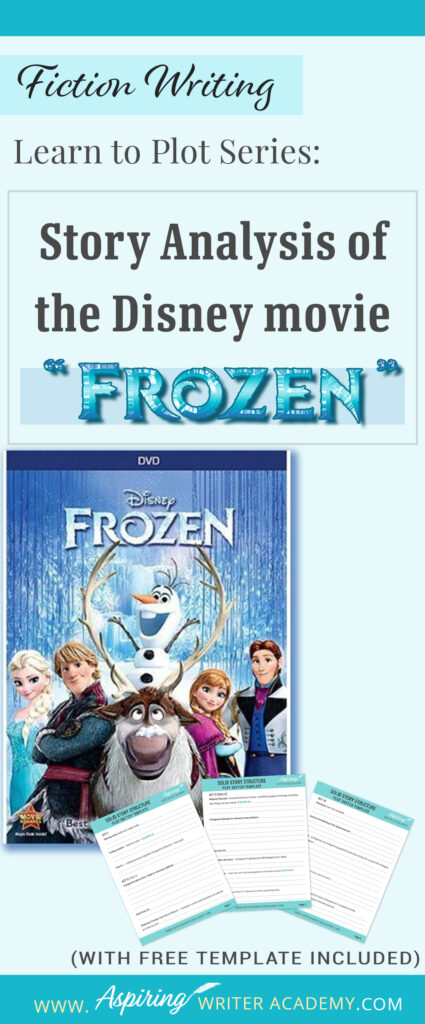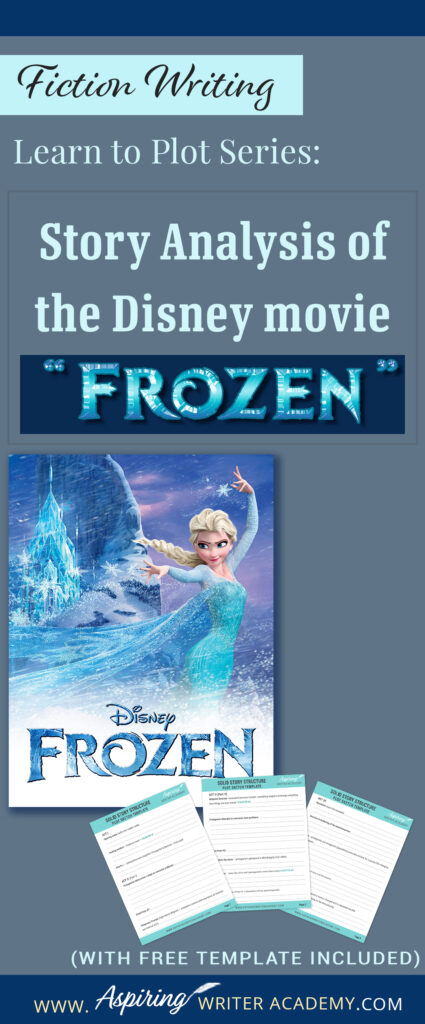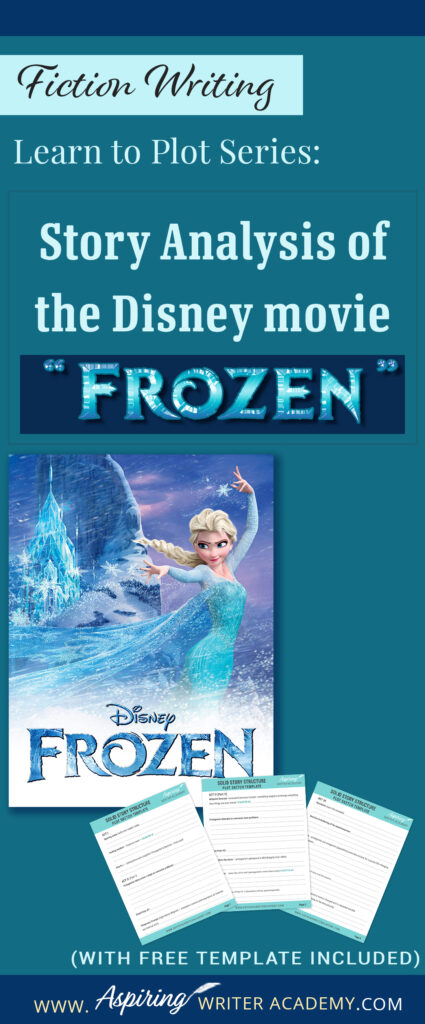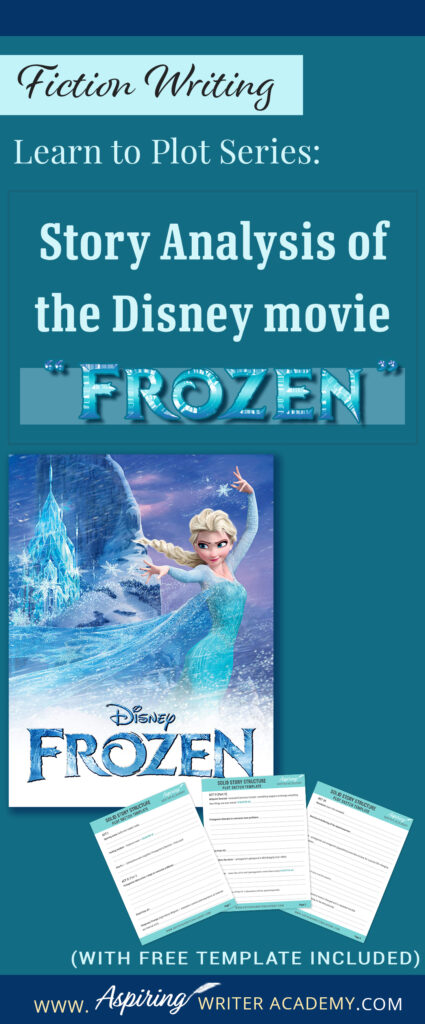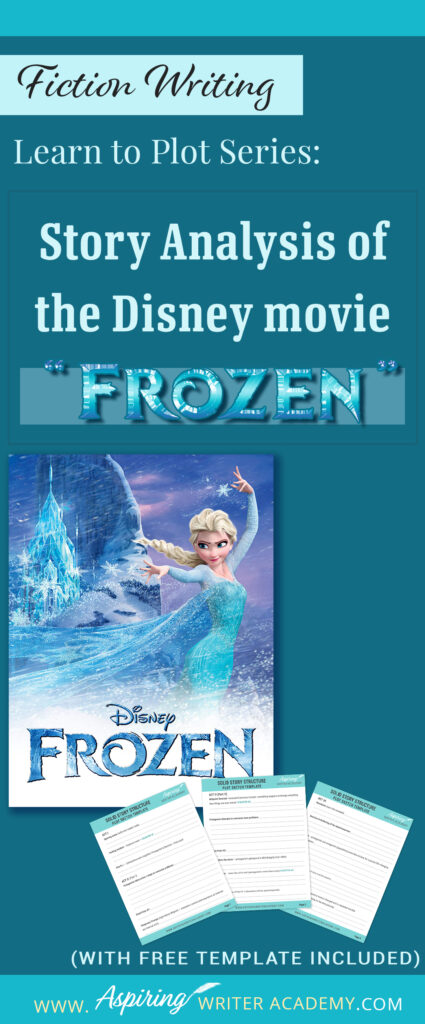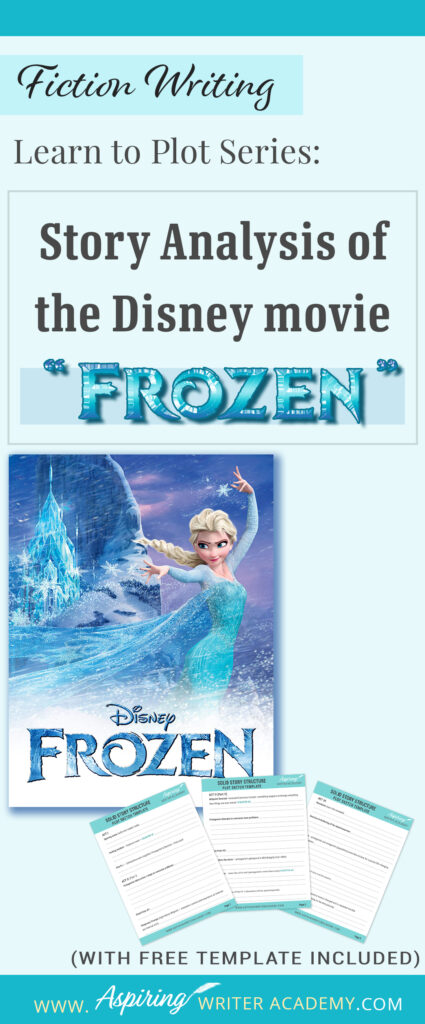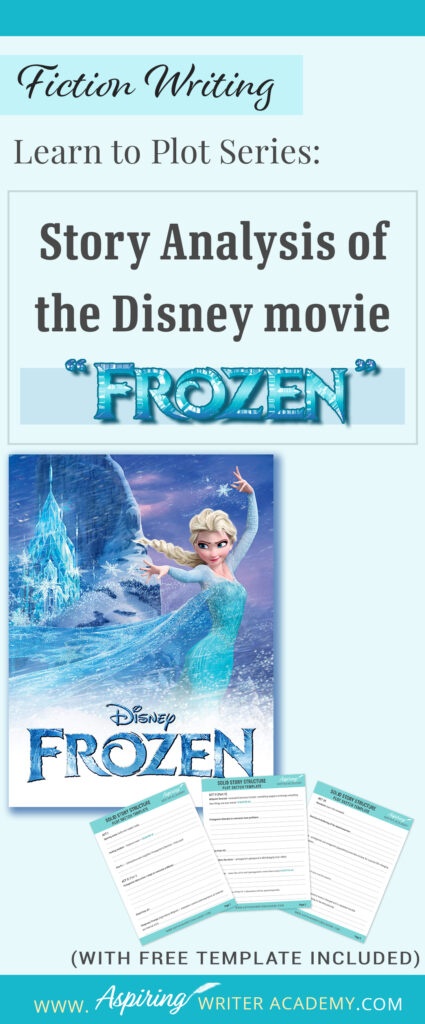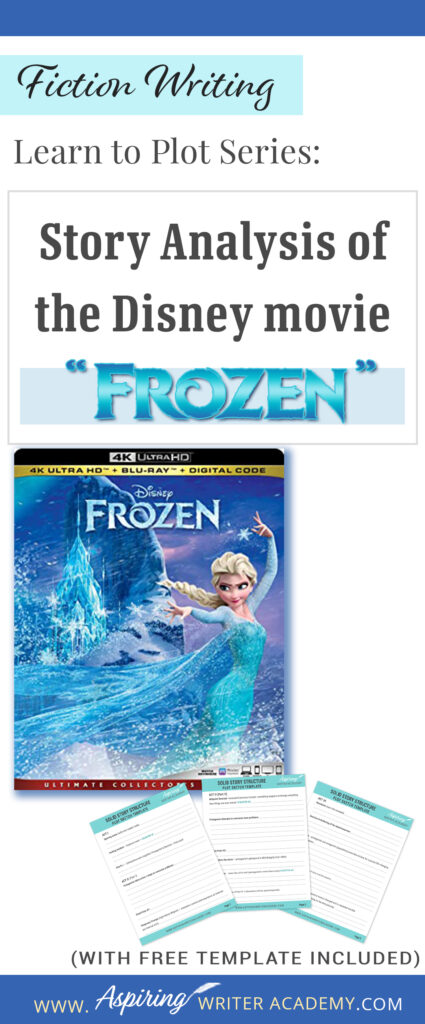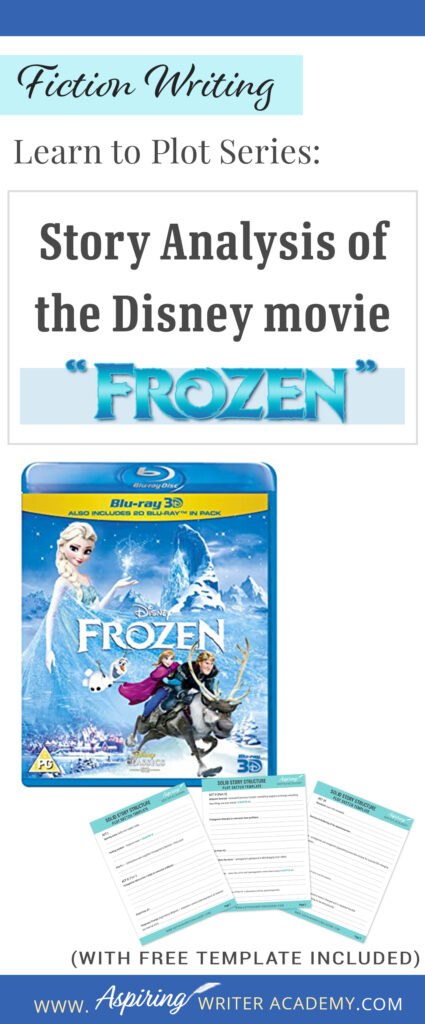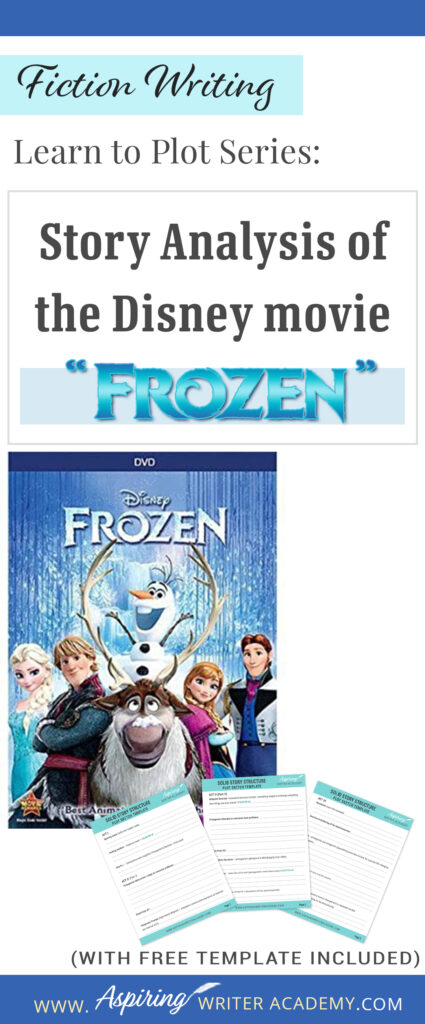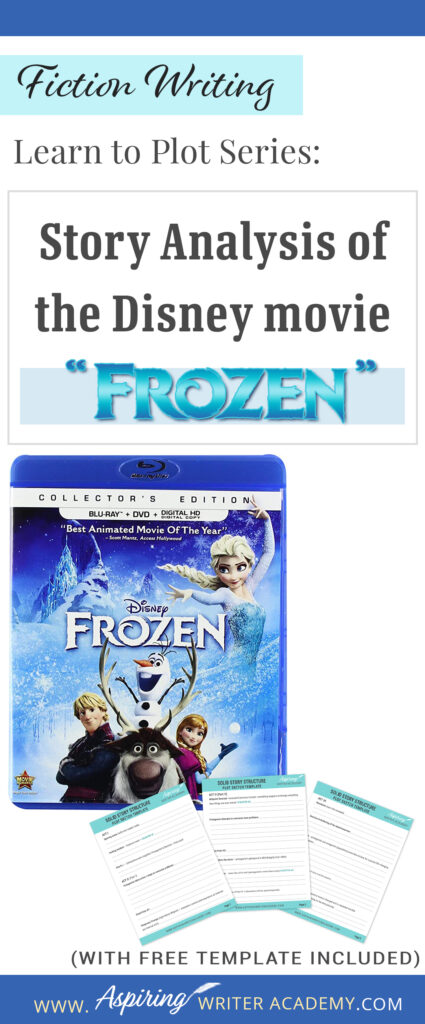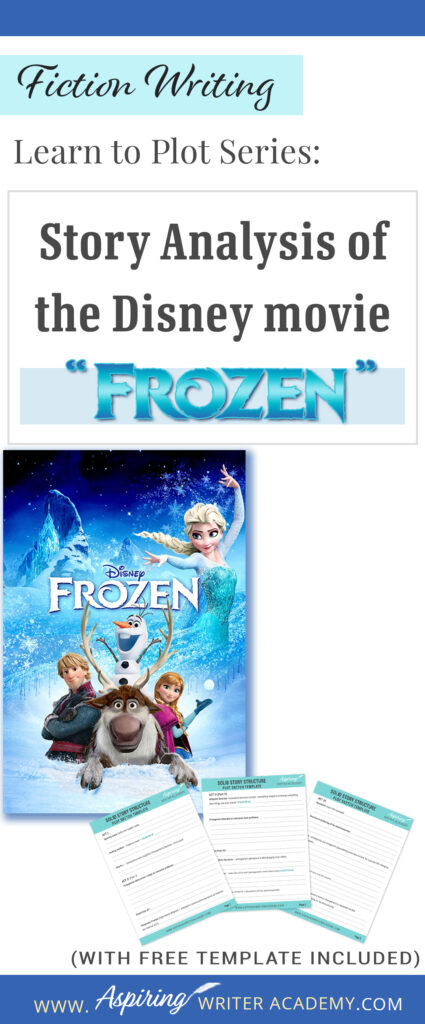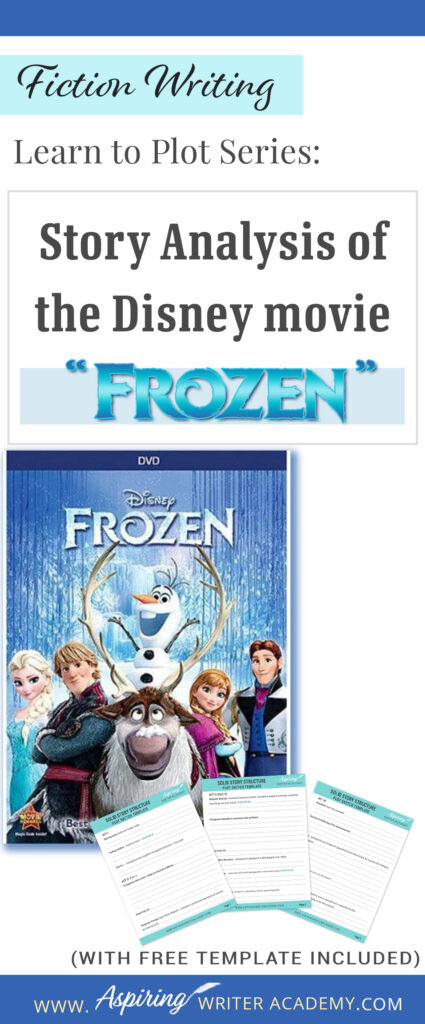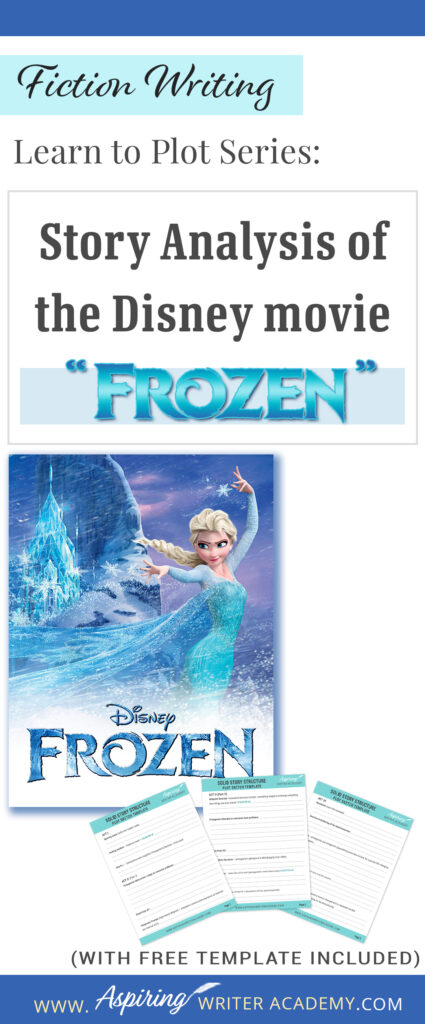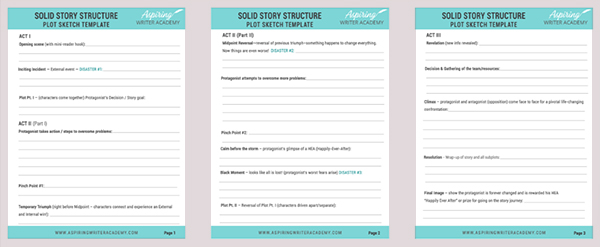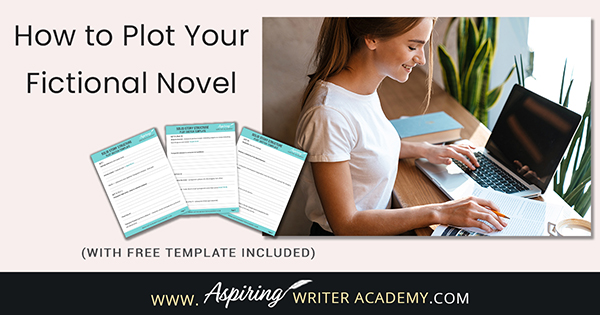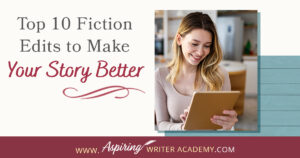Learn to Plot Fiction Writing Series: Story Analysis of the Disney movie “Frozen”
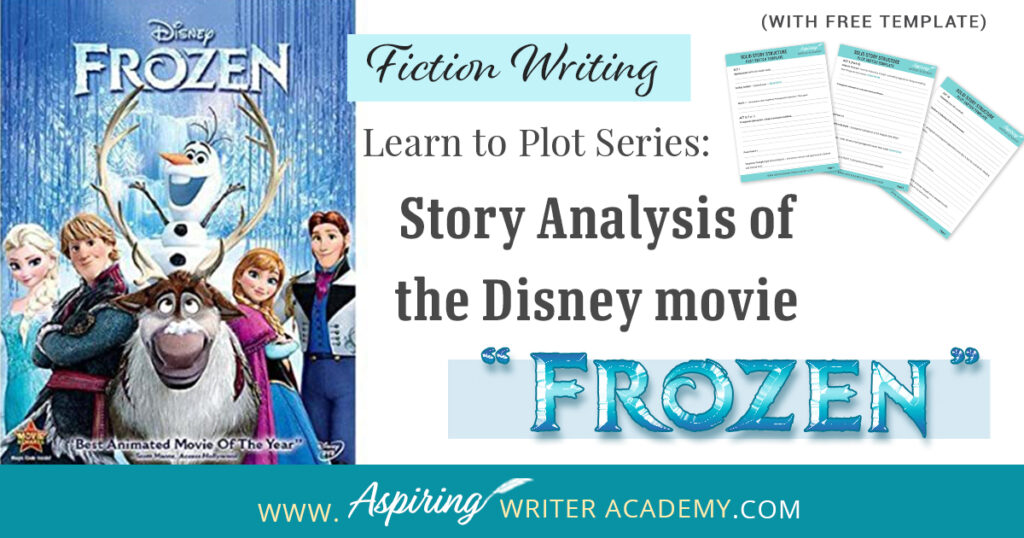
The best way to learn story structure is to analyze good stories. Can you readily identify each plot point in every movie you see or book you read? Or do terms like ‘inciting incident,’ ‘midpoint reversal,’ and ‘black moment’ leave you confused?
In our Learn to Plot Fiction Writing Series: Story Analysis of the Disney movie “Frozen” we will show you how to recognize each element and provide you with a Free Plot Template so you can draft satisfying, high-quality stories of your own.
Walt Disney Animation Studios Movie Blurb:
Fearless optimist Anna sets off on an epic journey, teaming up with rugged mountain man Kristoff and his loyal reindeer Sven, to find her sister Elsa, whose icy powers have trapped the kingdom of Arendelle in eternal winter. Encountering Everest-like conditions, mystical trolls and a hilarious snowman named Olaf, Anna and Kristoff battle the elements in a race to save the kingdom.
Inspired by "The Snow Queen" story by Hans Christian Andersen, the Disney movie, “Frozen” released March 18, 2014 and featured cartoon characters voiced by Kristin Bell, Josh Gad, Idina Menzel, Jonathan Groff, Santino Fontana.
Watch Now on Amazon: https://amzn.to/3Zkjtxl
One of the best ways to learn story structure is to analyze as many movies and books as you can. We suggest you watch movies because you can see the whole story played out before you visually in approximately two hours, which may be quicker than reading an entire book.
We also suggest that you watch the movie with our Free Downloadable Solid Story Structure Plot Template beside you so that you can write down each plot point as soon as you see it appear on the screen. Do this twenty or so more times and you will soon be on your way to becoming a story structure expert!
Click to download our free Solid Story Structure Plot Sketch Template to help you analyze books or movies, and plot stories of your very own.
Warning! This post contains story spoilers. If you have not already seen the movie and do not want any story spoilers the first time around, you might want to watch the movie for enjoyment then watch it a second time using this post to help you identify each story element.
ACT I
Opening Scenes:
What do the opening scenes of “Frozen” accomplish? How do they serve to set up the story?
- Setting.
First, you need to establish the ‘ordinary world.’ When the movie opens, we see a scene sequence featuring a team of men using tools to chop and pull ice blocks out of the frozen lake with large tongs. They load the ice blocks onto sleds which they take to the village (where there is also a castle.) The tiny boy Kristoff and his reindeer Sven are on the lake bank and try to help. Arendelle, is a Norwegian-inspired kingdom.
This sets the stage that the season is winter, the introduction of ice, and by the clothes they wear we see that this is set in the early 1800’s. (The main storyline takes place in July 1843.) With a title like Frozen and the introduction of ice, the viewer can safely assume this story will feature a lot of cold, snowy scenes.
- First scene opens with an interesting situation (initial problem).
The story opens with the characters facing an initial problem, which acts as a hook, to grab the reader’s attention. This isn’t the main problem yet, but a situation or event to get the story rolling. It is a scene that will tie into the major problem later.
While it is never a good idea to open a novel with back story, there are exceptions. Ideally, you want to sprinkle the backstory in only as needed and reveal more of the past later, once you’ve got the story going. However, in Disney films, and many children’s stories, opening with the backstory wound or incident that changed things for the characters in the past, and it works. Perhaps because these stories are shorter than novels and it is important to understand right from the beginning how things got to be this way when the true story begins.
In Frozen, we are introduced to the main characters Elsa and Anna (who at this point are still children, the daughters of the king and queen.) Anna tries to wake Elsa up to play. Anna pleads with her sister to ‘do her magic’ and sings, “Do you want to build a snowman?”
Elsa uses her magic to create snow inside the castle and make a snowman named Olaf. However, Anna gets hit with an accidental snow blast to the head, causing one strand of her hair to turn white. Her parents take her to the trolls in the forest for healing. And the head troll says, taking a hit to the head is better than one to the heart, which is foreshadowing for what will happen later in the story.
The head troll suggests they alter Anna’s memory, so she doesn’t remember Elsa has magic. They think this will protect Anna and we see the trolls have the power to switch memories. The head troll switches Anna’s memory of building Olaf inside the castle to a scene that happened outside.
Their parents are told Elsa’s powers will only grow so they give her a pair of protective gloves to wear at all times to suppress her power until she can learn to control it. They also limit Elsa’s contact with others by reducing the castle staff and locking the courtyard gates to keep the townspeople from seeing her.
Backstory wound:
Because of what happened to her sister, Elsa fears her powers and afraid she will hurt those she loves.
Anna is sad Elsa won’t play with her anymore. She doesn’t know why. Because of the need to hide Elsa, Anna has not had much contact with the outside world either.
And tragically, they do not even have the love of their parents, the king and queen, who were in a shipwreck and drowned at sea.
Introduction of fairytale, mythology, or fantastical elements: The Trolls
Just for fun, we need to talk about the trolls.
Some viewers speculate that there is a hidden subplot with these trolls that most people may not see. In ancient lore, trolls were rumored to steal blonde-haired, blue-eyed babies.
When Anna’s parents take her to be healed by the trolls, we see that young, blonde-haired, blue-eyed Kristoff and his reindeer Sven are watching from the bushes.
Kristoff reveals he does not have family and we assume he is an orphan, so it isn’t exactly kidnapping, but a troll does pop out of the bushes behind them and says, “Cuties! I’m going to keep you.” Later, Kristoff refers to these trolls as his family, the ones who raised him.
Also keep in mind, we now know that these trolls have mind-altering capabilities.
- Introduction of the main characters, their personalities, and the character’s relationships with one another. Also hint at the internal (relationship) conflict and escalating external conflict.
In Frozen, we now jump ahead in time to the present story. Elsa is turning 18 years old and everyone is excited for coronation day, when she will be crowned queen. The kingdom will open the castle gates for a whole day to celebrate.
Anna is excited to attend a ball, and dance, and maybe meet ‘the one’ she will marry. She is excited to see people, be noticed, see her sister, and maybe even find true love.
Elsa has quite the opposite reaction. She is dreading this day, fearing she may not be able to conceal her magic. She vows that she cannot let anyone find out. This is the escalating external conflict. Also notice that Elsa’s strength, her special ability, is also her weakness, the one thing that can bring her down if she is found out.
Anna wants so much to be close to her sister, but Elsa fears what may happen and wants to keep her sister away to protect her. This is the internal relationship conflict. We understand what is keeping the two sisters apart and until they work this out, there will never be a satisfying resolution.
Genre: It is important to note here that unlike many other Disney princess stories, that Frozen is not technically a romance. It is a story of two sisters. If this were an adult novel, it would be considered women’s fiction. While there is romance in it, the romance is not the story focus. The focus is on the relationship between the sisters. So, it is a fictional relationship story that includes magic and romantic elements.
Because the opening scene was back story, events that happened in the past, we now see another group of ‘set up’ scenes introducing who the characters are now to set up the present story.
- Anna falls backward into a boat and a charming, handsome man takes her hand and helps her up. Anna learns he is Prince Hans from a neighboring kingdom and they instantaneously fall in love. Although the couple seem genuinely suited for one another, the short time frame shows how much Anna has been isolated from others and her vulnerability in believing this could be true love. Her weakness.
- Elsa is crowned queen in a ceremony that requires her to take off her gloves and grasp a scepter in one hand and an orb in the other. The orb and scepter start to freeze, and she quickly hands them off to someone else and puts her safety gloves back on.
Cameo appearances are always fun for the reader/viewer. Readers love when characters from your other books show up to make a brief appearance. It is a treat. In Frozen we see Flynn Rider and Rapunzel (from the Disney movie Tangled) in the crowd of people who are coming to see Elsa’s coronation.
- We hear the stilted conversation between the sisters and realize they do not even know what to say to one another anymore. It’s awkward. Even if they do still have a love of chocolate in common. Anna wishes they could always be together, like this day, but Elsa pulls back and says they can’t.
- Anna dances with Hans and when he asks about her white streak of hair, she says she dreamed it turned that color when she was kissed by a troll. (Reminding us of the mind altering.) Prince Hans of the Southern Isles proposes, and the audience assumes he is the romantic hero of this story and that Anna has met her true love.
Avoid Being Predictable (Predictable=Boring!)
To avoid being totally predictable, the story is set up like other Disney romances but alas! Hans is not the hero; he is the villain! When this surprise is revealed later, it is a complete twist on what’s expected.
Ask yourself: How can you take an old story or cliché plot and insert a twist to make it completely brand new and fresh from what the audience has seen before? How can you make your story different from what is expected?
The clues to the unexpected twist must be subtly inserted right from the beginning, so when the truth is revealed, the reader can understand that it was right there in front of them but they didn’t see it.
In these beginning passages, Hans reveals that he has 12 older brothers, making it unrealistic he will ever have a chance at the throne. When they sing, he also gestures toward her castle and says he wants to find a place of his own one day. The motivation is there for him to later try to take the kingdom for himself.
Then there is the symbolism of the gloves, which cover up truth. Elsa and Hans are both seen wearing gloves. Later, Elsa’s gloves come off, exposing the secret she has been keeping – her magic. And Hans takes his gloves off when he reveals his true motives toward the end of the story.
However, at this point, the viewer is totally fooled and thinks Hans is a good guy. And the reader feels Anna’s hurt when Elsa refuses to let them marry.
Note: All of these ‘details’ are set up pieces that will show up again later and impact the story. Everything your character needs at the end should be set up in the beginning so it is believable for the reader/viewer.
Ask—who are these characters and what will they need?
Inciting Incident:
After the opening scenes have introduced the characters and set up the genre, time period, location, hinted theme, and general pacing of the story, the protagonist is hit with the inciting incident, which rocks his (or her) ‘ordinary world’ and turns his life upside down. This serious problem cannot be ignored.
The protagonist must now decide how to deal with this serious problem, which becomes his new focus for the remainder of the story. The action plan to overcome this serious problem becomes the protagonist’s story-worthy goal.
- After Elsa refuses to allow Anna and Prince Hans to marry, believing they have not known each other long enough to fall in love, Anna argues that Elsa is always shutting her out and accidently pulls off Elsa’s glove. In anger, Elsa uses magic and ice covers the castle floor. The townspeople are afraid and call it sorcery. And when Elsa runs across the lake on ice, the fjord and the whole kingdom freezes in an eternal winter.
Plot Point I:
Plot Point I is the agreement between characters or decision the main character makes to accomplish a new story-worthy goal triggered by or in response to the inciting incident.
The Inciting Incident forces the main characters to make a Decision (on what to do – a course of action.) This decision ends Act I. The main characters will unite to overcome the Inciting Incident problem.
- Hans wants to go with Anna to help find her sister but Anna says no and leaves him in charge of the kingdom while she’s away. Hans appears sincere in his concern for what has happened and agrees to Anna’s request to keep the kingdom safe by saying, “On my honor.”
This is similar to Plot Pt. I in many romances where the hero and heroine come together to solve a problem or make an agreement. This also helps trick the viewer into thinking this is the main romantic couple. However, Anna is not staying with Hans but leaving to go after Elsa. Anna is going on the ensuing story journey alone to find her sister.
This is Anna’s new story-worthy goal, which also sets up the story question: Will Anna be able to find her sister, mend their relationship, and convince Elsa to come back and unfreeze the kingdom from an eternal winter?
The audience is hooked and will continue watching/reading until the end of the story when this question is answered.
Her decision, her commitment, is Plot Pt. I, the turning point which ends ACT I.
It is a turning point that changes the story and turns it in a new direction. It is a ‘disaster’ for Elsa, a game-changing moment. It is also a game-changing moment for Anna and her relationship with her sister. Plot points always need to pivot the relationship in a significant way.
If you are not familiar with the elements of solid story structure for popular fiction, you may want to see our post, How to Plot Your Fictional Novel, to help you further understand the specifics of what should be included in each section.
ACT II (Part I)
Now we journey into the main body of the story where the characters are learning to navigate their new ‘world/situation.’ The characters are learning, growing, being tested in their skills and in their relationship with one another. They are acquiring the know-how to face and deal with what is to come during the later segments of the story.
- Elsa, who has always been told to be a ‘good girl’ and instructed not to let anyone see her powers, is suddenly set free to test out the true extent of her magic. She sings “Let it go!” and builds herself an ice castle up in the wintry mountains where she is all alone. She can use her magic with no fear, no rules, and experiences true freedom for the first time. This is a place where she can truly be herself and she vows never to go back.
Introduction of new characters / gathering of the team.
- Anna falls in a river and is cold. She knocks on a trading post cabin door to buy supplies for her journey and meets the now adult, Kristoff, who sells ice for a living. Quite the opposite of her interaction with Hans, Anna finds she has nothing in common with Kristoff at all and they banter back and forth. There seems that there is no attraction.
- Kristoff thinks people are bad and is thrown out when he calls the owner of the trading post a crook. Kristoff’s only friend is his reindeer, Sven. Despite their rocky introduction, Anna finds Kristoff and Sven in a barn and demands he take her up the North Mountain in his sled in exchange for the tools he needed and carrots for Sven. (This agreement is the real Plot Pt. I decision, agreement between hero and heroine, for yes, it is Kristoff who is the real hero, and not Hans. But see how it is sneakily done, again to help fool the viewer.)
- The fun bickering between Kristoff and Anna continues, building their relationship. Kristoff scoffs that her engagement after only one day to Hans was not true love.
Escalating Events:
- Wolves attack! Kristoff, Anna, and Sven jump a ravine and Kristoff loses his sled. Anna saves him from falling in the ravine and promises to replace his sled and supplies if he continues to help her. Grumbling, Kristoff only agrees so he can get a new sled.
Pinch Point #1:
This emotional moment usually occurs about midway through the first half of Act II.
The first pinch point serves to remind the main protagonist all he could lose if he doesn’t attain his goal (Anna’s relationship with Elsa.) Pinch Point #1 also motivates him to continue forward with renewed resolve. He will not give up!
- Anna and Kristoff meet the recreated Olaf, a talking snowman from Elsa and Anna’s youth, and Anna is certain that it was Elsa who built him. They need Olaf to lead them to Elsa so she can bring back summer. Olaf is disillusioned and dreams of summer, not realizing it could lead to his demise when he melts.
- The stakes are raised for Kristoff as he realizes that his ice block trading profession depends on Elsa bringing back summer. No one will buy ice from him if it is readily available everywhere in the kingdom with an eternal winter. He must help Anna, or he may lose his business!
More escalating events:
- As the movie jumps back to Hans, we see he is handing out blankets, coats, and other goods to the people in the kingdom to help them during winter, even against the rebuke of other officials who think he should not. Again, Hans still appears to be the hero, someone who genuinely cares. And when Anna’s horse returns without its rider, Hans commands soldiers go with him to find Anna, for she must be in trouble!
Temporary Triumph:
In most stories the characters experience an unexpected win in the external plot thread that triggers a celebratory win or triumph between the characters in the internal plot thread. There can be an understanding between characters at this point, a more detailed revelation of the past. Secrets may be revealed, there is new insight, like a parting of the curtains moment.
In a romance, this is where the characters may share some backstory and kiss. It looks like the characters may be able to achieve their goal and will get their happily-ever-after. This is a moment of hope, that yes, the character can win.
- Anna finally makes it to Elsa’s ice castle and goes in alone despite protests from Olaf and Kristoff, who worry for her safety. Anna and Kristoff have now become friends.
- The sisters talk, and it looks like their relationship might also be okay. Anna now understands why Elsa wears the gloves, keeps away, and why she had to leave. Anna also gives insight to Elsa, who didn’t know she’d placed the kingdom into an eternal winter. Elsa is sorry but doesn’t know how to reverse it.
ACT II (Part 2)
Midpoint Reversal
Bam! Just when everything seems fine and the goal within reach, an event happens at Midpoint, the second major plot point, to turn the story (and all the plot threads) in a different direction again. Disaster #2 changes everything and reverses the short-lived temporary triumph. In a relationship story, it changes the relationship.
While many of the lessons learned in the first half of Act I may have been more exploratory or reactive, the second half is stepping out to use and test those lessons proactively. The characters have now been enlightened as to what is really going on.
- Elsa still wants to protect Anna and wants her to leave her be in her ice castle. And when Elsa uses her magic, Anna once again gets accidentally hit with a snow blast—this time to the heart. (Which the viewer already knows is worse to the head.) This was foreshadowed in the beginning and raises the stakes. This reaffirms for Elsa that she can never have a relationship with others.
- To make Anna and her friends leave, Elsa has her huge snow troll chase them off. Anna, Kristoff, Sven, and Olaf run for their lives, desperately attempting to escape this monster.
Pinch Point #2:
About halfway through the second half of Act II, we have Pinch Point #2. Another moment to pull on the heartstrings. While Pinch Point #1 may have led the main character to see all they had to lose if they did not press forward with their goal, Pinch Point #2 leads them to see all they might gain.
- Kristoff sees Anna’s whole head of hair turn white and he fears for Anna’s health and realizes their future is in jeopardy if she doesn’t get help. He takes her to see his family, the trolls, who he’d previously told her were “Love Experts.” He saw long ago how the trolls healed a young girl from this same ailment, although he does not realize that girl was Anna.
The Calm Before the Storm:
This is a moment when the story takes a slight pause so the audience can catch their breath. This can be another moment of hope that all will be well, similar to the temporary triumph. The character may see or experience something to give them hope for the future or a reason to press on.
- Kristoff tells Anna it was just him and Sven until the trolls took him in when he was young. He is nervous to introduce Anna to his “family” and Anna thinks he is crazy when all she sees is a pile of large rocks. However, the rocks spin and transform and she sees they are trolls.
Back to the Trolls:
- The trolls are so excited that Kristoff has brought a girl and immediately want to set them up as a couple. The trolls point out Kristoff’s good points to Anna (even though he might be a bit of a fixer-upper) and the trolls are all set to marry them. But Kristoff tells the trolls that she is engaged to someone else.
- In the song the trolls sing, they say her engagement is a ‘minor thing, a flex arrangement’ and that they do not see a ring. They say she is also a bit of a ‘fixer-upper’ implying they can fix her up. In fact, one troll says, “Get the fiancé out of the way and the whole thing will be fixed!” (Without Hans, true love with Kristoff would have a chance to unfold.)
Now, let’s go back to the speculative troll subplot for just a minute.
Is it possible that the trolls used their mind-altering capabilities to change Hans into the villain of this story just so they could match Anna up with Kristoff?
After the movie is over, one has to wonder. But at this point, Hans is still set up to be the hero, and Anna’s engagement keeps her and Kristoff apart. (This is their main relationship conflict, since now, it appears Kristoff and Anna are starting to really care for one another.)
However, the head troll says he cannot remove Anna’s frozen heart. Only an act of true love can help her. Despite the trolls’ matchmaking, Kristoff does not believe he is Anna’s true love and thinks he must get her back to Hans in order to save her life.
More Escalating Events:
- Meanwhile, Hans and his men go to rescue Princess Anna and battle against Elsa’s snow troll monster. The soldiers enter the ice castle and try to kill Elsa with crossbows. But for the first time, Elsa finds she is able to control her powers and use magic to defeat the soldiers without hurting them.
- Hans calls out, “Queen Elsa, don’t be the monster they think you are,” still seeming to be the good guy, and when one of the soldiers aims to shoot her direct, Hans shoots an arrow up at the chandelier above, and it crashes down on her, trapping her, but she is unhurt. (It could be that he was still trying to make himself look good.)
- Elsa wakes up back in her family’s castle dungeon in the kingdom of Arendelle with metal gloves on her hands chaining her to her cell. She sadly realizes the gloves are a custom fit and had been pre-made by her parents to use in case her magic got out of control. Elsa looks out the window and sees that Arendelle really is completely frozen and in a moment of self-reflection says, “What have I done?” In writer terms, this is also referred to as ‘The Man in the Mirror Moment.’
- Hans tells her that he will do what he can but other’s don’t want to let her go (a reference back to her song of freedom) out of the dungeon.
The Black Moment:
The black moment is the dark night of the soul, the bleakest moment, which is also the third major turning point, Game Changer, or Disaster #3. It appears that all hope is lost.
- Kristoff brings Anna to Arendelle and tells the townspeople to get Hans and make sure she’s safe. He cares about her but must walk away and the viewer thinks there is no hope for them to fall in love and marry.
- Anna tells Hans that he needs to kiss her and only an act of true love can save her. But Hans suddenly reveals that he doesn’t love her!
Once again, let’s revisit the speculative troll subplot:
Up until this point in the story, Prince Hans seems like a real hero, the perfect match for Anna. They have nearly everything in common. In the beginning of the story, even before Prince Hans learned she was a princess, it appeared he really liked her. When Anna turned away to go back to the castle after their first meet and was no longer looking, he gazed after her with a dreamy look on her face. All throughout the story, he seemed like the hero, the good guy.
And then we have this sudden, unexpected twist and we have to wonder:
Was Hans the villain all along, planning to try to take the kingdom from the beginning? It is certainly possible, looking back at some of the clues.
Or did the trolls use some of their ‘mind-altering magic’ to get him out of the way so Anna and Kristoff can get together?
- Hans states:
"As thirteenth in line in my own kingdom, I didn't stand a chance. I knew I'd have to marry into the throne somewhere...
As heir, Elsa was preferable, of course, but no one was getting anywhere with her. But you...
You were so desperate for love, you were willing to marry me, just like that! I figured after we married, I'd have to stage a little accident for Elsa.
But then she doomed herself, and you were dumb enough to go after her."
With stating this Hans takes his gloves off both figuratively and literally – as he reveals his true identity and real character. He wants to kill Elsa and plans to be the hero who brings back summer and saves Arendelle from destruction.
- Hans locks Anna in her room and tells others that Princess Anna is dead, killed by Queen Elsa. He tells the people that he and Anna married, that they said their vows before she died. This allows him to take over the kingdom and he charges Elsa with treason and sentences her to death!
Plot Point II:
Plot Point II follows quickly on the heels of the Black Moment. This is when the characters separate or are driven apart due to the events of the Black Moment. The protagonist finds himself alone, struggling with what to do next.
-At Plot Pt. II the characters are driven apart. (This is a reversal of Plot Pt. I where the characters all came together.)
- Because of the events of the Black Moment, Kristoff separated from Anna, Anna is separated from Hans who locked her away where no one can find her, and Elsa is locked in the dungeon sentenced to death.
ACT III
Revelation and Decision:
Then, suddenly the protagonist gets a new piece of information that changes the situation, and the characters can see how they might succeed in their battle against the external antagonist which they must face. The revelation (new information revealed) helps the protagonist to make a decision.
- Elsa realizes she must escape her death sentence and creates a snow cloud blast that helps her break out of the dungeon.
- Kristoff sadly believes Anna is with her true love but when he sees a large snow cloud rising above Arendelle, he thinks Anna might be in trouble and decides to rush back to the kingdom.
- The snowman, Olaf, opens the locked door and finds Anna freezing to death. Olaf decides to build a fire and gets Anna over to it to warm her. This decision also involves sacrifice, for now Olaf is melting.
- Anna realizes it wasn’t true love with Hans. She repeats what Elsa had said to her that day at court when Elsa refused to let Anna and Hans marry. “I don’t know what true love is.”
The Revelation for Anna comes when Olaf reveals that Kristoff loves her and he and Sven are seen coming back for her! Anna realizes she loves Kristoff too and decides she must get to him. True love’s kiss can save her after all!
Re-gathering of the Team or Resources:
- As Anna and Kristoff rush toward one another, they are joined by Sven and Olaf and must overcome this last obstacle: dodging a falling frozen ship and avoid getting hit by the ice chunks breaking as they cross the frozen fjord at great peril.
Climax:
This is the most exciting scene sequence in the entire book or movie. This is a face-to-face confrontation between the protagonist (and his team) and the opposition. Either the protagonist succeeds once and for all or he fails. Everything is put on the line. It will not be easy.
- Hans faces Elsa and says Anna is dead and that it is Elsa’s fault. (Anna’s heart has been frozen.) Of course, this is a lie.
- Kristoff races toward Anna on the frozen fjord and as Hans is about to kill Elsa with a sword, Anna steps in the way and saves her sister’s life. The frost has spread from Anna’s frozen heart to freeze her entire body and she becomes an ice stature, frozen in place. When the sword hits Anna’s frozen raised hand, the sword freezes and becomes so brittle that it shatters.
- Elsa is heartbroken and everyone is sad, thinking Anna sacrificed herself and is now gone. The whole movie, Elsa has not been able to touch anyone, but now she hugs her sister. Elsa is the only one who can, because cold doesn’t affect her.
- However, it was an act of true love which was needed, not true love’s kiss, and when Anna stepped in to save Elsa, the curse was broken. Anna slowly unfreezes and Elsa realizes that love is the key to changing ice to summer and controlling her magic powers.
Resolution:
This is where the main storyline and all sub-plots are wrapped up with their reaction to what transpired at the Climax. The story journey has changed the protagonist. He/she can do things that they couldn’t do in the beginning. But the protagonist must do something to prove he’s changed. Show it.
The conflicts in both the external plot layer and the internal relationship plot layers have been faced and defeated. They have ‘won!’
- Elsa turns the kingdom of Arendelle back to summer, saving the kingdom from eternal winter.
- The snow melts, and Olaf starts to melt as well, but Elsa gives him his own personal snow cloud that hovers above his head to keep him cold.
- Hans tries to make up with Anna but she punches Hans overboard off a boat (mirroring her backward fall into a boat when they first met which frames the story like bookends) and he is put in jail and shipped back to his own kingdom. The old weasel duke from another kingdom who has always wanted to cause trouble for Arendelle is also kicked out.
- Anna owes Kristoff a sled from the beginning of the story and she gives him one. He is also made the official Arendelle ice master. Anna and Kristoff admit their feelings for one another and kiss!
- And the snowman Olaf and the reindeer Sven become best friends.
Final Image:
This is the very last image or scene of the entire story, a ‘capping off’ scene featuring the main characters of the story. (Since this is not a real romance, the romantic subplot was wrapped up first, and the real relationship plotline between the sisters is saved for last.)
- Elsa proves she is in control of her magic and uses her powers to create an ice skating rink for the people. Elsa is no longer afraid of hurting Anna and now the sisters can be together. Happily Ever After. And the sisters also agree that they will never close the castle gates and shut out people from their lives ever again!
Themes:
Long after the movie is over, the message (theme) is intended to get people to think. The theme should never be directly stated to allow the reader to come up with their own thoughts on what the theme is and how it relates to them. Different people will see totally different themes in your writing, perhaps themes that you never even intended, and that is okay.
Some of themes of Frozen could be:
- The importance of family and friendship
- Love should come with no strings attached, unconditional love
- Sibling love conquers all, the power of sisterhood
- The recurring symbolic theme of doors and the need to be opened
- Don’t judge a book by its cover
- Dream big, like Olaf’s seemingly impossible dream of enjoying summer, don’t set limits on yourself and what you can do (which is also like Elsa).
- The importance of self-acceptance, being yourself
- Stop bottling your emotions
- Overcoming loneliness
- People need one another, no one is an island, we can’t do everything on our own
- Sacrifice for one another can be noble
- The importance of truth
- Love can change the world
Does the ending of your story lead the audience to ponder a life question? Or does it reinforce a value deemed as important to society? What is the unspoken message your story has to say? (Unspoken, because you should never have your characters say the intended message outright. The message comes from the telling of the story itself, the journey.)
Additional Thoughts:
How does this story structure line up with your own writing? Have you included all the steps or are you missing some?
Bottom of FormI hope that you have enjoyed our Learn to Plot Fiction Writing Series: Story Analysis of the Disney movie “Frozen” and have downloaded the Free Solid Story Structure Plot Template to analyze more books and movies, or perhaps to outline a story of your own.
If you like more help developing your story, you may wish to download our Free Brainstorming Your Story Idea Worksheet
If you have any questions or would like to leave a comment below, we would love to hear from you!
Do you find it difficult to create compelling antagonists and villains for your stories? Do your villains feel cartoonish and unbelievable? Do they lack motivation or a specific game plan? Discover the secrets to crafting villains that will stick with your readers long after they finish your story, with our How to Create Antagonists & Villains Workbook.
This 32-page instructional workbook is packed with valuable fill-in-the-blank templates and practical advice to help you create memorable and effective antagonists and villains. Whether you're a seasoned writer or just starting out, this workbook will take your writing to the next level.
Our Goal for Aspiring Writer Academy is to help people learn how to write quality fiction, teach them to publish and promote their work, and to give them the necessary tools to pursue a writing career.

ENTER YOUR EMAIL BELOW
TO GET YOUR FREE
"Brainstorming Your Story Idea Worksheet"
7 easy fill-in-the-blank pages,
+ 2 bonus pages filled with additional story examples.
A valuable tool to develop story plots again and again.
Other Blog Posts You May Like
How to Handle Negative Book Reviews
Learn To Plot Fiction Writing Series: Story Analysis of the Movie “Top Gun: Maverick”
How To Plan an Amazing Children’s Book Launch Party
5 Reasons Your Writing Sucks! (And How to Fix It)
How to Brainstorm a New Novel Using Goal, Motivation, and Conflict
How to Write Query Letters (for Fiction)
Slingshot Week: How to Set New Goals for Writing in 2023
The Pros and Cons of Writing Holiday Fiction (Collections & Anthologies)
Biggest Self-Publishing Mistakes New Authors Make
Novel Writing Tips: Don’t Bury the Dialogue!
What to Include in Your Author Newsletter
Why Authors Need an Email Newsletter
How to Choose Characters to Populate Your Fictional Story
Fiction Writing: Critique Group Etiquette & Warning Signs of a Good Group Gone Bad
Scene & Sequel: The Secret to Plotting an Epic Novel
Scene & Sequel: The Secret to Plotting an Epic Novel (Part 2)

is a multi-published author, speaker, and writing coach. She writes sweet contemporary, inspirational, and historical romance and loves teaching aspiring writers how to write quality fiction. Read her inspiring story of how she published her first book and launched a successful writing career.

